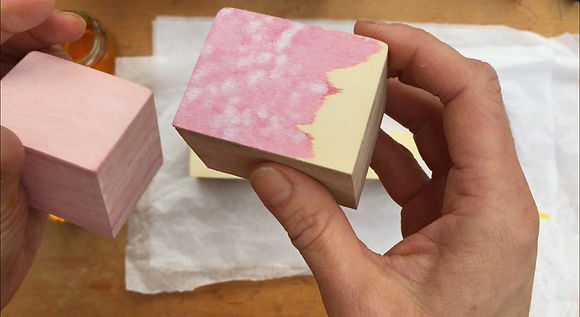What kind of paint do I need for painting Toys? Can Wood Stains be mixed?
This page will give you information on the different Paints and Stains available at Tiny Land and what can be achieved with them.
All my paints are Toy Safe and conform to EN71-3. All can be mixed with each other for different effects.
I am currently making 3 types of paint.
1. A Wood Stain available in vibrant, transparent dyes or vibrant and pastel pigments
2. A plastic-free acrylic substitute paint made with food grade pigments
3. A solid, oil/water emulsion paint that provides some water resistance when dry
For the difference between dyes and pigments see my blog here:
Wood Stains are effectively inks for a transparent (semi-opaque for the Pastel range) vibrant effect for use as
Playdough colouring Watercolours Making rainbow rice, pasta or shells
(Image by BusyBusylearning) (Image by Shrabakatarzya)
-
Dying wood to show the grain
(Image by Cornishmama17) (Image by BusyBusylearning) (Image by CarlasTreasures)
Wood Stains come in 120ml or 41ml Jars. Instructions are here:
The vibrant types are made from food dyes and can be mixed together.
The pastels are made from pigments which suspend and so require shaking before use.
They can all be mixed together. Vibrants and Pastels when mixed can dry with splotchy results. The Paper Glue/Primer will help to prevent this. See "Do I need a primer?" below.
- Fauxcrylics. Acrylic-free pigmnent paints for watering down or using neatly as required. For use on paper, card or wood. Can be used to create detail on toys. Very similar to Watercolours or Acrylics and are not waterproof. Can be sealed with the liquid or Lemon Balm Sealant. 41ml or 120ml Jars
Fauxcrylics can be used for
Rock Painting Painting Background and detail on toys Painting pictures on canvas
(image by Jedimumtricks)
The following paints are temporarily discontinued but may be in stock:
- Wonderpaint. A ready-mixed diluted version of Fauxcrylics. A high quality pigmented poster paint for use on paper, card and some woods 120ml. Mix colours with white for a more solid or pastel look. 120ml Jars.
- Fingerpaint. Desiged to be super washable, these DYE paints produce a softer mark on the page than Wonderpaints and are therefore suitable for younger children, for use on card or paper. 120ml jars.
- Scented Paint. The same paint as the finger paint with natural fruit extracts. (The EU does ot permit scented fingerpaint) Comes in120ml jars.
Here I used Wood Stain (left), Wonderpaint (middle) and Fauxcrylic at varying dilutions (right)
Do I need a primer?
When we look at wood, it can look very smooth.
Particularly if it has been sanded.
However wood has many holes, which were useful to absorb water when
the tree was alive. So when putting coloured liquid on wood directly
it is taken into all grooves and holes.
If the colourant is a pigment then it has a particle size that means if the
paint collects into these areas it will be very visible to the naked eye.
Dyes can also be visibly patchy if the wood is very porous.
To prevent this, primer is a transparent material that flows into the holes instead, and dries to create a smoother surface. This surface can then be painted over. The primer itself needs to also be able to be stained, or else it will act as a masking fluid - preventing the underlying wood from being coloured.
Tiny Land primer is perfect for this. When it dries, the water evaporates, leaving the primer material in grooves. To make sure the grooves are filled adequately , 2 coats will be needed. To prevet bleeding 4 coats are required. Maybe more if you have very porus wood or if it has been attacked by wood boring beetle.
If you are mixing vibrant wood stains with white pigment paints to make a pastel, then primer will be needed to support the pigments.
Here I mixed white fauxcrylic with pink wood stain without primer on the wood - see how the white pigments have collected?



















